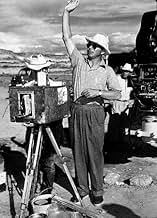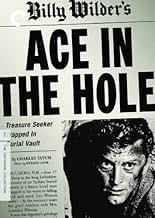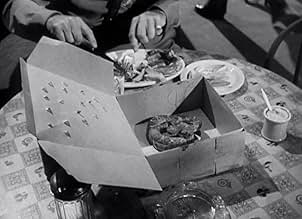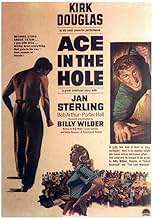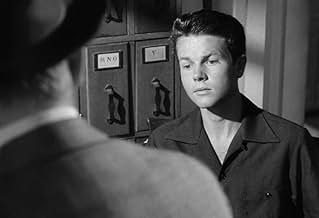CALIFICACIÓN DE IMDb
8.1/10
41 k
TU CALIFICACIÓN
Un ex-periodista frustrado atrapado trabajando para un periódico de Albuquerque explota una historia sobre un hombre atrapado en una cueva para reavivar su carrera, pero la situación rápidam... Leer todoUn ex-periodista frustrado atrapado trabajando para un periódico de Albuquerque explota una historia sobre un hombre atrapado en una cueva para reavivar su carrera, pero la situación rápidamente se convierte en un circo fuera de control.Un ex-periodista frustrado atrapado trabajando para un periódico de Albuquerque explota una historia sobre un hombre atrapado en una cueva para reavivar su carrera, pero la situación rápidamente se convierte en un circo fuera de control.
- Dirección
- Guionistas
- Elenco
- Nominado a 1 premio Óscar
- 5 premios ganados y 3 nominaciones en total
Robert Arthur
- Herbie Cook
- (as Bob Arthur)
Roy Regnier
- Nagel - New York Editor (replaced by Richard Gaines)
- (escenas eliminadas)
Oscar Belinda
- Barker
- (sin créditos)
Opiniones destacadas
This is a movie I have loved since the first time I saw it as a child. Kirk Douglas plays the lead role in "The Big Carnival", or "Ace in the Hole" as it was originally titled. As down and out former ace newspaper reporter Chuck Tatum, he finds himself broke in the southwest and manages to talk himself into a reporting job with a small town newspaper. He and a cub photographer are sent to cover a snake hunt and on the way they come across a more interesting story. A man hunting Navaho artifacts got caught in a cave in.
Tatum, after visiting the man, Leo Minoso in the cave, has visions of Floyd Collins and a Pulitzer prize dancing in his head. Through blackmail and manipulation of the story, Tatum sells his soul and his journalistic ethics in his quest for a chance at the big time again.
This movie was ahead of it's time in estimating how low the media would go to sell a story. Tatum leads the carnival of onlookers, vendors and other reporters wanting a piece of the story until the inevitable tragic ending occurs. He realizes too late how he has turned a simple event into a tragedy and become part of the story instead of a reporter. Kirk Douglas turns in a powerful performance.
Tatum, after visiting the man, Leo Minoso in the cave, has visions of Floyd Collins and a Pulitzer prize dancing in his head. Through blackmail and manipulation of the story, Tatum sells his soul and his journalistic ethics in his quest for a chance at the big time again.
This movie was ahead of it's time in estimating how low the media would go to sell a story. Tatum leads the carnival of onlookers, vendors and other reporters wanting a piece of the story until the inevitable tragic ending occurs. He realizes too late how he has turned a simple event into a tragedy and become part of the story instead of a reporter. Kirk Douglas turns in a powerful performance.
10zinkster
One of Billy Wilder's great movies, with a superb acting job by Kirk Douglas as the cynical, glory-seeking and even desperate reporter whose only goal is get back in the limelight by regaining his former big-city news desk job.
The idea of such a newspaper reporter manipulating events to stretch out a story at the expense of and disregard for the victim still seems nearly inhuman, but Douglas' performance makes it instantly believable. The story scenario in which locals, then passers-by and finally distant tourists gravitate to and then make a festival or circus out of the event (the film was also released under the title "The Big Carnival") is supported by the real events on which the story was most likely based: the West VA mine disaster in 1925 that trapped miner Floyd Collins and was reported for 17 days, much as in the film, by local newspaperman Skeets Miller, who crawled into the mineshaft for face-to-face interviews with the trapped and doomed Collins.
This movie fits nicely into the Film Noir genre, although it takes place largely under the hot, harsh glare of the Arizona sun, highlighting the sweat and grime visible on the characters' skin and creating a visual metaphor for the sorry state of their souls. I wonder if Henri-Georges Clouzot saw this film before he began filming "The Wages of Fear," because the visually pervasive atmosphere of sweat and filth and opportunism are equally present in both.
The idea of such a newspaper reporter manipulating events to stretch out a story at the expense of and disregard for the victim still seems nearly inhuman, but Douglas' performance makes it instantly believable. The story scenario in which locals, then passers-by and finally distant tourists gravitate to and then make a festival or circus out of the event (the film was also released under the title "The Big Carnival") is supported by the real events on which the story was most likely based: the West VA mine disaster in 1925 that trapped miner Floyd Collins and was reported for 17 days, much as in the film, by local newspaperman Skeets Miller, who crawled into the mineshaft for face-to-face interviews with the trapped and doomed Collins.
This movie fits nicely into the Film Noir genre, although it takes place largely under the hot, harsh glare of the Arizona sun, highlighting the sweat and grime visible on the characters' skin and creating a visual metaphor for the sorry state of their souls. I wonder if Henri-Georges Clouzot saw this film before he began filming "The Wages of Fear," because the visually pervasive atmosphere of sweat and filth and opportunism are equally present in both.
A powerful toasting of the media of the day. Imagine what this would have been like in the age of television. Kirk Douglas plays a self-centered heel, and does so very well. I also liked Jan Sterling as Lorraine. It's true that there is no really sympathetic character in this film, except maybe Leo, the man trapped in the cave. Someone wrote that he too, wasn't a sympathetic character, because he was trapped while collecting Indian artifacts for sale, but I don't think that would have bothered anyone in 1951. The tone of the film throughout was one of total cynicism, that seems a bit out of place for the times. Maybe that's why this movie was not a commercial success. It fits much better now, though, since everyone has seen the media behaving in such disgraceful fashion. However, that may rob it of some of its (probably intended) shock value. Grade: A
There are some films that when you see them you ask why they aren't available to rent or own. This is one of them. I had the fortune of seeing this hidden gem on the big screen and was pleasantly surprised.
With Kirk Douglas playing a Reporter whose been around the block, always looking for a shortcut, comes across an opportunity to exploit a man caught in a mine shaft. I have read where critics had considered the circus atmosphere of the the film unrealistic. It seems Mr. Wilder got the last laugh. If you are interesting in great dialogue and good story telling, I suggest you find this
With Kirk Douglas playing a Reporter whose been around the block, always looking for a shortcut, comes across an opportunity to exploit a man caught in a mine shaft. I have read where critics had considered the circus atmosphere of the the film unrealistic. It seems Mr. Wilder got the last laugh. If you are interesting in great dialogue and good story telling, I suggest you find this
Billy Wilder's first commercial failure, but one of his best films, almost up there with "Sunset Blvd." Ambitious reporter Chuck Tatum (Kirk Douglas) finds out a man is trapped in a collapsed mine. By spewing out bogus engineering, he manages the rescue of the poor man to become more complicated, and time consuming then needed. Meanwhile, it becomes an amazing news item, something that makes Tatum the best known reporter in the country. However, everybody's luck runs out at the end. Perhaps the cause of failure of this film is that there are no sympathetic characters here. Douglas plays a total creep, the trapped man's wife is a floozy "I'm not going to pray for him! Praying ruins my nylons!" in the film. Even the trapped man is somebody who was poking around Indian graves. The screenplay, and the lead performances are top class. The extensive location photography, and somewhat documentary look of the film makes the film feel more modern than most 1951 films. Billy Wilder calls this film "the runt of his litter" Don't be so harsh, Billy, it's an excellent picture!
¿Sabías que…?
- TriviaAfter the film was released, it got bad reviews and lost money. The studio, without Billy Wilder's permission, changed the title to "The Big Carnival" to increase the box office take of the film. It didn't work. On top of that, Wilder's next picture, Infierno en la tierra (1953), was a hit and he expected a share of the picture's profits. Paramount's accountants told him that since this picture lost money, the money it lost would be subtracted from the profits of "Stalag 17".
- ErroresWhen Lorraine and Chuck are talking out in front of Minosa's store by the gas pumps, reflections of the crew moving around behind the camera can be seen in the store windows.
- Citas
Charles Tatum: Bad news sells best. Cause good news is no news.
- ConexionesFeatured in AFI Life Achievement Award: A Tribute to Billy Wilder (1986)
- Bandas sonorasThe Hut-Sut Song
(uncredited)
Written by Leo Killion, Ted McMichael and Jack Owens
Sung by Richard Benedict and Kirk Douglas
Selecciones populares
Inicia sesión para calificar y agrega a la lista de videos para obtener recomendaciones personalizadas
Detalles
Taquilla
- Presupuesto
- USD 1,800,000 (estimado)
- Total a nivel mundial
- USD 2,300,087
- Tiempo de ejecución
- 1h 51min(111 min)
- Color
- Relación de aspecto
- 1.37 : 1
Contribuir a esta página
Sugiere una edición o agrega el contenido que falta


